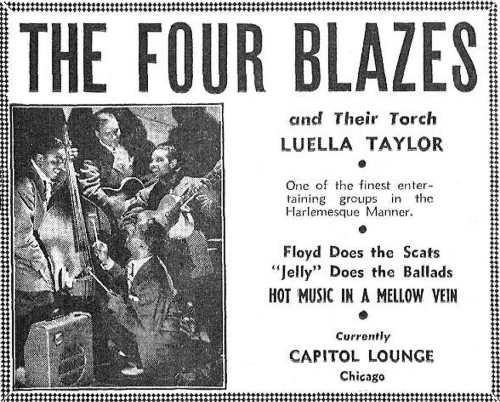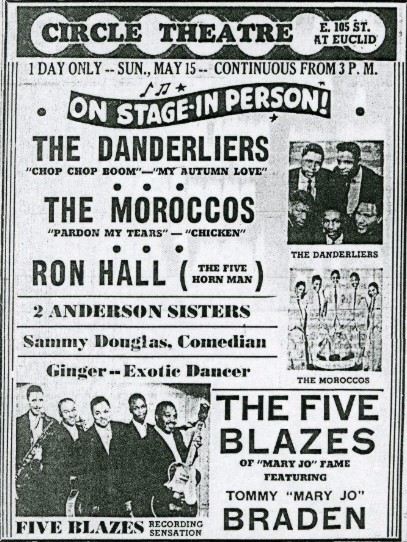THE FIVE BLAZES
Holy blazes! How many Blazes were there? This influential vocal group recorded as the Four Blazes, the Three Blazes, the Five Blazes, and even the just plain Blazes on a bad counting day in the studio. The group was founded in 1940 as the Four Blazes by drummer Paul Lindsley "Jelly" Holt, already a veteran of sizzling string groups such as the Five Rhythm Rocketeers. The other charter Blazes, previously known under the nasty band moniker of the Four Dusty Demons, were Jimmy Bennett and William "Shorty" Hill, who between them covered guitar, tipple, ukulele, and mandolin, with Prentice Butler on bass. All sang and did impressions as well. In 1941, swing stalwart Floyd McDaniel switched from acoustic to electric guitar and replaced Bennett, considerably changing the sound of the group in the process. A further addition was made in 1945 in the form of Pittsburgh pianist Ernie Harper. Legendary Chicago bandleader Duke Groner was the Blazes' bass at some point between 1943 and 1946.
By this time, it seemed prudent to change the name to the Five Blazes, but this caused confusion, since a Los Angeles-based group also called itself the Four Blazes at the time. The group even recorded a number, entitled "Chicago Blues," as if intentionally obscuring those who track down missing groups by looking for locational clues in song titles. The Chicago group's recording career actually didn't begin until 1947, with Aristocrat. As the Five Blazes, the group was only the second act to cut sides for what would become an important Chicago independent label, eventually to be transformed into the Chess blues kingdom. Three years later, it was back to the Four Blazes, with Ernie Harper going out in 1950. (He died around the same time.) At the end of 1951, a bassist named Tommy Braden pulled into town with saxophonist J.T. Brown's band. Braden's singing and songwriting would be central to the Blazes' sound for the remainder of the group's existence. His 1952 ditty "Mary Jo" hit the top on the R&B charts. Recordings made in this period utilized the talents of session reed player Eddie Chamblee, who pitched in on both clarinet and tenor sax. Although when he overdubbed himself on "Perfect Woman," the result was so imperfect that even a heavy dose of reverb couldn't fix it.
The group continued recording until nearly the mid-'50s, but the final recording sessions indicate more lineup changes. An organist named Gordon Fairholt is suspected of having played piano on some tracks, but has yet to be completely proven as the culprit. In 1953, there were newspaper advertisements for the Five Blazes, suggesting further incendiary growth. The fire was stoked further by the presence of sax giant Red Holloway on the last sessions and not Chamblee, as sometimes listed in discographies. This session produced the classic "Did You Ever See a Monkey Play a Fiddle," once again written by Braden, who left soon thereafter to form his own Tommy Braden Quintet. The Four Blazes went on with another vocalist, though Braden still seemed interested in the studio projects and was back in the fold for the last session in 1955. The group broke up the same year. Tommy Braden died in 1957, Jelly Holt carried on singing with the Four Whims (retiring in the early '60s), while Floyd McDaniel (1915-1995) continued on the scene, including years with the Ink Spots. Chicago blues fans noticed he was still around in the '80s and he made at least one CD after his rediscovery.




Comentarios